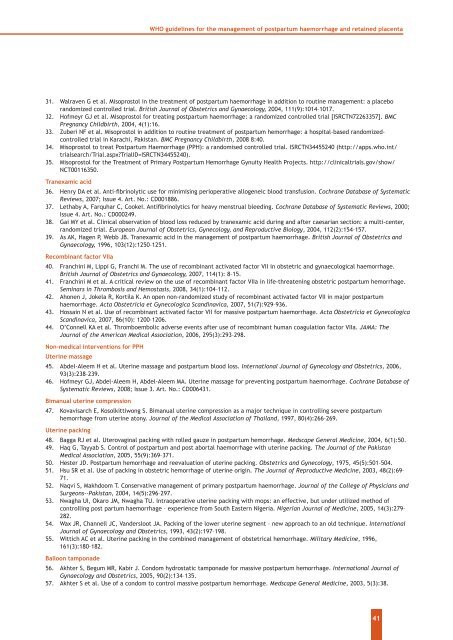WHO guidelines for the management of postpartum haemorrhage ...
WHO guidelines for the management of postpartum haemorrhage ...
WHO guidelines for the management of postpartum haemorrhage ...
Create successful ePaper yourself
Turn your PDF publications into a flip-book with our unique Google optimized e-Paper software.
<strong>WHO</strong> <strong>guidelines</strong> <strong>for</strong> <strong>the</strong> <strong>management</strong> <strong>of</strong> <strong>postpartum</strong> <strong>haemorrhage</strong> and retained placenta<br />
31. Walraven G et al. Misoprostol in <strong>the</strong> treatment <strong>of</strong> <strong>postpartum</strong> <strong>haemorrhage</strong> in addition to routine <strong>management</strong>: a placebo<br />
randomized controlled trial. British Journal <strong>of</strong> Obstetrics and Gynaecology, 2004, 111(9):1014–1017.<br />
32. H<strong>of</strong>meyr GJ et al. Misoprostol <strong>for</strong> treating <strong>postpartum</strong> <strong>haemorrhage</strong>: a randomized controlled trial [ISRCTN72263357]. BMC<br />
Pregnancy Childbirth, 2004, 4(1):16.<br />
33. Zuberi NF et al. Misoprostol in addition to routine treatment <strong>of</strong> <strong>postpartum</strong> hemorrhage: a hospital-based randomizedcontrolled<br />
trial in Karachi, Pakistan. BMC Pregnancy Childbirth, 2008 8:40.<br />
34. Misoprostol to treat Postpartum Haemorrhage (PPH): a randomised controlled trial. ISRCTN34455240 (http://apps.who.int/<br />
trialsearch/Trial.aspx?TrialID=ISRCTN34455240).<br />
35. Misoprostol <strong>for</strong> <strong>the</strong> Treatment <strong>of</strong> Primary Postpartum Hemorrhage Gynuity Health Projects. http://clinicaltrials.gov/show/<br />
NCT00116350.<br />
Tranexamic acid<br />
36. Henry DA et al. Anti-fibrinolytic use <strong>for</strong> minimising perioperative allogeneic blood transfusion. Cochrane Database <strong>of</strong> Systematic<br />
Reviews, 2007; Issue 4. Art. No.: CD001886.<br />
37. Lethaby A, Farquhar C, CookeI. Antifibrinolytics <strong>for</strong> heavy menstrual bleeding. Cochrane Database <strong>of</strong> Systematic Reviews, 2000;<br />
Issue 4. Art. No.: CD000249.<br />
38. Gai MY et al. Clinical observation <strong>of</strong> blood loss reduced by tranexamic acid during and after caesarian section: a multi-center,<br />
randomized trial. European Journal <strong>of</strong> Obstetrics, Gynecology, and Reproductive Biology, 2004, 112(2):154–157.<br />
39. As AK, Hagen P, Webb JB. Tranexamic acid in <strong>the</strong> <strong>management</strong> <strong>of</strong> <strong>postpartum</strong> <strong>haemorrhage</strong>. British Journal <strong>of</strong> Obstetrics and<br />
Gynaecology, 1996, 103(12):1250–1251.<br />
Recombinant factor VIIa<br />
40. Franchini M, Lippi G, Franchi M. The use <strong>of</strong> recombinant activated factor VII in obstetric and gynaecological <strong>haemorrhage</strong>.<br />
British Journal <strong>of</strong> Obstetrics and Gynaecology, 2007, 114(1): 8–15.<br />
41. Franchini M et al. A critical review on <strong>the</strong> use <strong>of</strong> recombinant factor VIIa in life-threatening obstetric <strong>postpartum</strong> hemorrhage.<br />
Seminars in Thrombosis and Hemostasis, 2008, 34(1):104–112.<br />
42. Ahonen J, Jokela R, Kortila K. An open non-randomized study <strong>of</strong> recombinant activated factor VII in major <strong>postpartum</strong><br />
<strong>haemorrhage</strong>. Acta Obstetricia et Gynecologica Scandinavica, 2007, 51(7):929–936.<br />
43. Hossain N et al. Use <strong>of</strong> recombinant activated factor VII <strong>for</strong> massive <strong>postpartum</strong> <strong>haemorrhage</strong>. Acta Obstetricia et Gynecologica<br />
Scandinavica, 2007, 86(10): 1200–1206.<br />
44. O’Connell KA et al. Thromboembolic adverse events after use <strong>of</strong> recombinant human coagulation factor VIIa. JAMA: The<br />
Journal <strong>of</strong> <strong>the</strong> American Medical Association, 2006, 295(3):293–298.<br />
Non-medical interventions <strong>for</strong> PPH<br />
Uterine massage<br />
45. Abdel-Aleem H et al. Uterine massage and <strong>postpartum</strong> blood loss. International Journal <strong>of</strong> Gynecology and Obstetrics, 2006,<br />
93(3):238–239.<br />
46. H<strong>of</strong>meyr GJ, Abdel-Aleem H, Abdel-Aleem MA. Uterine massage <strong>for</strong> preventing <strong>postpartum</strong> <strong>haemorrhage</strong>. Cochrane Database <strong>of</strong><br />
Systematic Reviews, 2008; Issue 3. Art. No.: CD006431.<br />
Bimanual uterine compression<br />
47. Kovavisarch E, Kosolkittiwong S. Bimanual uterine compression as a major technique in controlling severe <strong>postpartum</strong><br />
hemorrhage from uterine atony. Journal <strong>of</strong> <strong>the</strong> Medical Association <strong>of</strong> Thailand, 1997, 80(4):266–269.<br />
Uterine packing<br />
48. Bagga RJ et al. Uterovaginal packing with rolled gauze in <strong>postpartum</strong> hemorrhage. Medscape General Medicine, 2004, 6(1):50.<br />
49. Haq G, Tayyab S. Control <strong>of</strong> <strong>postpartum</strong> and post abortal <strong>haemorrhage</strong> with uterine packing. The Journal <strong>of</strong> <strong>the</strong> Pakistan<br />
Medical Association, 2005, 55(9):369–371.<br />
50. Hester JD. Postpartum hemorrhage and reevaluation <strong>of</strong> uterine packing. Obstetrics and Gynecology, 1975, 45(5):501–504.<br />
51. Hsu SR et al. Use <strong>of</strong> packing in obstetric hemorrhage <strong>of</strong> uterine origin. The Journal <strong>of</strong> Reproductive Medicine, 2003, 48(2):69–<br />
71.<br />
52. Naqvi S, Makhdoom T. Conservative <strong>management</strong> <strong>of</strong> primary <strong>postpartum</strong> <strong>haemorrhage</strong>. Journal <strong>of</strong> <strong>the</strong> College <strong>of</strong> Physicians and<br />
Surgeons--Pakistan, 2004, 14(5):296–297.<br />
53. Nwagha UI, Okaro JM, Nwagha TU. Intraoperative uterine packing with mops: an effective, but under utilized method <strong>of</strong><br />
controlling post partum <strong>haemorrhage</strong> – experience from South Eastern Nigeria. Nigerian Journal <strong>of</strong> Medicine, 2005, 14(3):279–<br />
282.<br />
54. Wax JR, Channell JC, Vandersloot JA. Packing <strong>of</strong> <strong>the</strong> lower uterine segment – new approach to an old technique. International<br />
Journal <strong>of</strong> Gynaecology and Obstetrics, 1993, 43(2):197–198.<br />
55. Wittich AC et al. Uterine packing in <strong>the</strong> combined <strong>management</strong> <strong>of</strong> obstetrical hemorrhage. Military Medicine, 1996,<br />
161(3):180–182.<br />
Balloon tamponade<br />
56. Akhter S, Begum MR, Kabir J. Condom hydrostatic tamponade <strong>for</strong> massive <strong>postpartum</strong> hemorrhage. International Journal <strong>of</strong><br />
Gynaecology and Obstetrics, 2005, 90(2):134–135.<br />
57. Akhter S et al. Use <strong>of</strong> a condom to control massive <strong>postpartum</strong> hemorrhage. Medscape General Medicine, 2003, 5(3):38.<br />
41
















